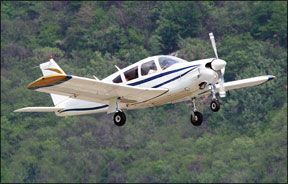Pip
Since its little more than a retractable Cherokee, the Arrow is a logical step-up airplane for pilots accustomed to Pipers fixed-gear four-seaters. Moving from one cockpit to the other, everything will be familiar, from gauge placement to systems
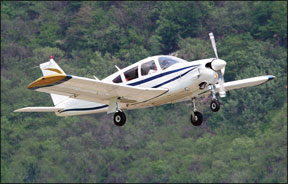
to handling and procedures. Thats no accident, of course: Offering a full line of airplanes was the basic marketing model for all of the major manufacturers in the 1960s and 1970s. As they started out in two-seat trainers, pilots were encouraged to step up into similar four-place, fixed-gear models, then to retractables from the same blood line.
While the market has changed, the Arrow soldiers on. Its a relatively ubiquitous airplane, available in many flavors ranging from the original, relatively sedate 180-HP version with its short, stubby wings to a fire-breathing, T-tailed turbocharged version perhaps best known for heat-management and runway-hogging issues: Even Piper has a bad day. A few quirks aside, though, some version or vintage of the Piper Arrow may be the right airplane at the right time for a prospective owner.
History
The original PA-28 owes its existence to John Thorpe, who designed an all-metal homebuilt that, after some modifications, became the first Cherokee. Introduced in 1962 as the Cherokee 150 and 160, the PA-28 gave Piper a badly needed shot in the arm in the low-end market. Cessna had a runaway success on its hands with the 172, and Pipers competition-the Tri-Pacer – was downright dowdy by comparison.
The original Cherokee did well, and was soon joined by the 180 and 235, giving Piper a strong lineup of fixed-gear singles meeting many missions. Since all Cherokees share the same basic airframe, the company was also able to realize some manufacturing economies.
By the mid-1960s, Piper began considering the PA-28 as a candidate to compete in the light four-place retractable market, then dominated by Mooney with Beechs least expensive retractable-the Debonair-costing a third again as much as a Mooney. Cessna had no comparable airplane at all, and Pipers Comanche would go out of production in the mid-1970s.
Piper folded the gear on its Cherokee 180 and in 1967 unveiled the first Arrow. It was every bit a Cherokee, from the fat, constant-chord Hershey Bar wing to the stabilator. The base price was $16,900, some $1350 less than the Mooney M20C Mark 21 (according to the Aircraft Bluebook Price Digest). However, the average
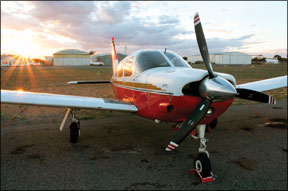
equipped price of an Arrow as delivered was actually about $2000 more than the Mooney. A Cherokee 180 from the same year had a base price of a mere $12,900.
The PA-28R-180 came with a constant-speed prop turned by a Lycoming IO-360-B1E engine. The new retractable gear was electromechanical (compared to Mooneys distinctive manual “Johnson Bar” arrangement), and had a unique feature designed to enhance safety: an auto-extension mechanism that would lower the gear if the airplane slowed below a certain airspeed. More on the Arrows gear system in a moment.
The original Arrow compared we’ll with the Mooney in some departments, such as roominess and cost, but fell short in terms of speed. Cruise was pegged at 141 knots, compared to 158 for the Mooney. Still, the Arrow was considerably faster than the carbureted, fixed-gear, fixed-prop (but otherwise identical) Cherokee 180.
After two years and sales of almost 1100 airplanes, Piper came out with a 200-HP version of the Arrow. An extra $500 bought pilots a Lycoming IO-360-C1C engine, a few knots, and a 100-pound boost in gross weight, though that was eaten into by a 79-pound increase in empty weight. The -C1C engine was more costly in other ways, too-it had a 1200-hour TBO, compared to 2000 for the 180. That short TBO has since been lengthened by fitting new exhaust valves, and its highly unlikely that any of the 1200-hour mills remain. The 200s TBO is now also 2000 hours.
The 200-HP Arrow was sufficiently more popular than the 180 that the latter was dropped in 1971. Starting with the 1972 model year, the airplane was redesignated the Arrow II. Its fuselage was stretched five inches, providing more rear-seat room; its wingspan increased 26 inches by widening the Hershey Bar design, and the stabilators span increased. This allowed 50 pounds more gross weight, and the addition of the long-awaited manual gear-extension override. Thanks to larger bearing dowels, the old 1200-hour TBO was boosted to 1400 hours. The next year marked the development of a redesigned camshaft and another TBO increase-to 1600 hours.
In the mid-1970s, Piper revamped its line of metal singles (leaving the Super Cub alone), starting with the bottom of the PA-28 line. Beginning in 1975, the airplane that had been the Cherokee 140 became the Warrior, sporting a new, semi-tapered wing of higher aspect ratio than the familiar Hershey Bar and a 150-hp engine. This new wing found its way onto the Arrow in 1977, creating the Arrow III. In that same year, Piper made a turbocharged version of the Arrow. More on this variant in a moment.
The new wing improved performance somewhat, most notably in terms of glide. It also gave pilots a healthy 24-gallon increase in fuel capacity.
The Arrow III lasted only two model years. In 1979, Piper made a controversial design decision, opting to equip many models with trendy, fashionable T-tails. The Arrow was no exception, and the result was dubbed “Arrow IV.” Predictably, performance suffered. Like many T-tail airplanes, the Arrow IV flies differently than Arrows with conventional tail feathers. The T-tail, depending on airspeed, is either very effective or far less effective than a conventional tail (which isn’t as prone to abrupt transitions between different flying regimes). This occurs because the stabilator sits up out of the propwash, and so is less effective at low airspeeds. Many pilots complain that the Arrow IV has squirrelly low-speed performance, with a tendency to over-rotate on takeoff. Others, who don’t try to fly the Arrow IV like the earlier models, look more favorably upon the T-tail. Regardless, some who have
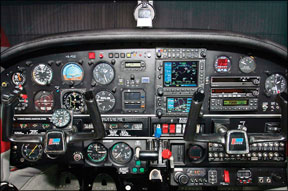
flown both report the T-tailed version also demands more attention to pitch trim when changing airspeeds.
During the general aviation slump of the late 1980s and early 1990s, Arrow production was spotty: The normally aspirated Arrow IV wasnt built for model years 1983 through 1987; only the Turbo Arrow IV was available. For model years 1988, 1989 and 1990, conventional tail, normally aspirated Arrows were made alongside T-tailed turbo models. The last three Turbo Arrow IVs were 1990 models; subsequent Arrows through current production all have conventional tails and lack turbos. No Arrows of any flavor carry 1991 or 1993 model designations; this was the time when Piper was on the rocks, searching for a buyer. One Arrow is labeled as a 1994 model.
Piper emerged from bankruptcy in 1995 as New Piper, a moniker dropped in 2006. Todays version-known simply as the “Arrow,” without any Roman numerals-is essentially an Arrow III, arguably the best of the bunch. The 2007 models base price is $323,850, which includes a single Garmin GNS430 but no autopilot.
MarketplaceWhen the Arrow was introduced, its only real competition came from Mooneys early M20s. Other manufacturers soon realized the viability of the market segment, however, and it wasnt long before other competitors appeared. Beechs offering was the rather lackluster (though roomy) Sierra, while Cessna weighed in first with the Cardinal RG, then the Cutlass. Rockwell got into the small retractable business with the Commander 112, and Mooney upped the ante with the landmark 201.
The average equipped prices of these airplanes when new in 1977 (the first year all of them were offered at once) ran as follows: Arrow III: $50,320; Cessna Cardinal RG: $50,095; Rockwell Commander 112: $61,295; Beech Sierra: $53,594 and Mooney 201: $57,420.
The marketplace has declared the Mooney the runaway winner in terms of non-adjusted appreciation: that same 1977 airplane has increased in value by 30 percent. The Arrow is second, up a little over 16 percent. The big loser is the Sierra, which has lost considerable value. Its worth noting the used marketplace doesnt like the T-tailed Arrow much, either: a 1979 PA-28RT-201 has not yet recovered its new average equipped price, while a 1978 Arrow III is worth about 15 percent more than its new cost.
The Mooney runs away from the rest in another sense as well: speed and efficiency, which have great value. This is food for thought, since the Arrow is no faster than, say, a Grumman/AGAC Tiger, an airplane that delivers this performance on 20 less horsepower with a fixed-pitch prop and fixed landing gear. It costs about 15 to 20 percent less to buy, and less to maintain.
Performance/handlingThe 200-hp Arrow is an unremarkable performer; the 180-hp version is, well, doggy. Cruise speeds range from 130 (180-hp) to 143 knots (normally aspirated 200-hp T-tail) and as high as 170 knots for a turbocharged version flown in the teens. The non-turbod Arrows consume nine to 12 gallons per hour, with the “blown” versions using around 14 gph when pushed. A Cessna Cardinal RG or Grumman Tiger will go as fast, while burning less fuel. And a Mooney 201, on the same fuel, goes the
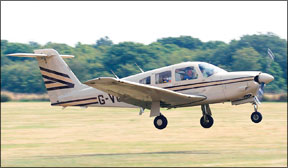
fastest. Still, the Arrow has a roomier interior than all but the Cardinal, and its useful load is the greatest: 1200 pounds.
The first two Arrows had somewhat limited range, thanks to their 48-gallon fuel capacity. Beginning with the taper-wing Arrow III, 72-gallon fuel tanks eliminated that problem. Taper-wing Arrow owners report as much as 6.5 hours endurance, while Arrow II owners sometimes wish for larger tanks.
The Arrow handles much like any PA-28, which is to say its fairly benign. Stalls are a non-event. The wing loading is lower than higher-performance retractables like the Bonanza/Debonair and Mooney, which means a less solid ride in turbulence and lower speeds. However, thats also a benefit during landing. Owners report few vices.
Climb performance is competent, but unremarkable. The Arrow is not a STOL airplane, but it doesnt eat up runway, either. During letdowns, the Arrows gear serves as an effective speed brake. The gear extension limit is close to the cruise speed (which really says more about the cruise speed than it does about the gear), so descents arent the problem they are in slick airplanes like the Mooney.
AccommodationsThe Arrows interior is quite comfortable. Piper deserves mention for its seat design in later aircraft, which have a crashworthy S-tube design meant to progressively collapse and absorb energy during an impact. This same basic design is used in the famed JAARS bush-plane seat. Piper also gets crashworthiness kudos for installing a thickly padded glareshield.
Heating and ventilation are both quite good, unlike some other airplanes in the class, with lots of overhead and floor vents. Egress is not the best, however, especially when compared to the double-doored Cardinal RG and Commander 112, and the Sierra with its separate passenger door. Further, the double-latch system can confuse passengers, particularly in an emergency: Be sure to brief them.
Piper chose long ago to put the engine gauges near the power controls, which makes a certain amount of sense, but wed rather see the gauges up in the pilots line of sight where theyre hard to miss.
Gear troublesThe Arrows automatic landing gear extension system was intended as a safety feature; Piper touted the Arrow as the perfect airplane for pilots transitioning to retractables. Many pilots and insurance underwriters embraced the “foolproof” gear system with some insurers even assigning lower rates. Alas, the system isn’t
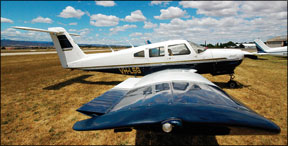
perfect, and didnt prevent landing gear-related mishaps in the Arrow.
Also the Arrows automatic gear extension system is a good example of how safety features can spawn new hazards even while eliminating old ones. In high-power, low-airspeed configurations, the system could either delay retraction or lower the gear at an unwanted time. Then there are Arrow pilots who lose their engines and decide to ditch with the gear up. Unfortunately, some forget to override the automatic extension system. The gear plops out seconds before splash down-sending the Arrow head over heels. Savvy Arrow pilots learned early on to “pin”-override-the system to keep the gear retracted when doing max-performance work.
There were enough “misunderstandings” by mid-1987 that Piper, then owned by Lear-Siegler, ordered the system deactivated because of concern over liability suits. It sold kits to do so, and told customers it wouldnt provide parts to repair the existing system. Piper sold 1400 kits.
A year later-then owned by M. Stuart Millar-the company withdrew its deactivation order, provided that pilots “take the necessary actions to assure that any pilot flying these aircraft are fully advised of the system and its proper operation.” In part, Piper was responding to the complaints of irate owners who believed the system worked often enough to be desirable.
That Troublesome TurboWhen Piper hung a 200-HP turbocharged Continental TSIO-360-F onto an Arrow III in 1977, the combination looked like a perfect match: the worlds premier economy retractable single and a powerplant promising high-tech performance at low-tech prices. The extra money-the average 77 Turbo Arrow III went out the door costing around $4600 more than its non-turbod sibling-boosted book max cruise speed from 149 KTAS to a whopping 177 at altitude. A new cowling rounded out the deal and announced to the ramp rats your bird was turbocharged.
Soon, however, the engine began earning a reputation as tricky to operate and prone to self destruction. It didnt help much when, in 1979, Piper combined its T-tail airframe with the turbod engine, even if the powerplant got a different suffix and much-needed TBO extension (from 1400 to 1800 hours).
The result was a handful on the runway: The T-tails tendency to encourage overrotation, coupled with the engines need for attention on the takeoff roll meant a busy time. On the good side: The engines fixed wastegate introduced legions of pilots to the term “bootstrapping.” For pilots transitioning from a normally aspirated Arrow, it was too tempting to run the throttle to its stop early in the takeoff roll, just as one would with the non-turbod version. Do that with the Turbo Arrow, though, and you’ll get a red “overboost” light very soon, often followed by your mechanics bill for the subsequent inspection.
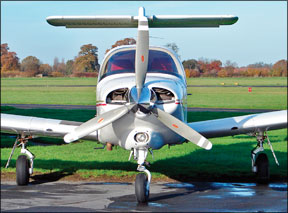
Instead, the favored technique was to run up the MAP to no more than 30 or so inches early in the takeoff roll, then forget about it while monitoring the other engine gauges and keeping the centerline straddled. When workload permitted-or runway length demanded-and after the system bootstrapped itself to around 35 inches, gently nudge the throttle so that around 39 or 40 in. were available; the engine likely would boost itself the rest of the way to its 41 in. Hg. manifold pressure limit and off you went.
Alas, the engine wasnt as bulletproof as Continental intended or Piper hoped. One five-year printout of FAA Accident and Incident Reports for the Turbo Arrow disclosed no fewer than 54 instances of powerplant failures. Furthermore, the engine stoppages werent the result of typical pilot errors such as fuel mismanagement, fuel exhaustion, etc. They occurred from failed connecting rods or rod bolts, broken crankshafts and damaged pistons.
Things got so bad that the National Transportation Safety Board in 1985 called for an airworthiness design review of the engine, citing a litany of component failures. Then-FAA Administrator Donald Engen rejected the request.
These days, things have calmed way down with the Turbo Arrow. A recent check of Service Difficulty Reports (SDRs) going back into the 1990s did not uncover any real trends with the Turbo Arrows engine, airframe or appliances.
Turbo ModsOne of the reasons for the Turbo Arrows recent reliability may be the aftermarket mods available. Two are significant: intercoolers from Turboplus and Airflow Systems, and an automatic wastegate. While Turboplus no longer offers them for Turbo Arrows, Airflow Systems (www.airflow-systems.com) is still in the market. Owners say they get a higher critical altitude with the intercoolers along with lower operating temperatures.
Meanwhile, in an effort to prevent bootstrapping on the Turbo Arrow and other aircraft with the TSIO-360 engine, Merlyn Products (www.merlynproducts.com) has taken an even more dramatic step and come up with an automatic upper deck controller that looks like the answer to a prayer for Turbo Arrow owners. It increases the critical altitude by 5500 feet while boosting cruise climb and speed slightly, and lowering CHT and oil temperatures significantly.
The ostensibly nifty benefits of this system are much lower turbo speeds, lower engine RPM settings at all altitudes and generally allowing lower engine operating temperatures.
Clubs, More ModsA variety of aerodynamic mods are available for PA-28s, from the usual flap and gap seals (Knots-2U, www.knots2u.com) to shoulder harnesses and one-piece windshields (Kosola, www.kosola.com) to the high-spiff-factor LoPresti (www.speedmods.com) cowling. Speed brakes can be had from Precise Flight (www.preciseflight.com), though the Arrow doesnt really need them.
As with any personal airplane, we strongly recommend joining a type club. Their expertise can save real money when tracking down common. Arrow owners have two excellent organizations from which to choose: The Cherokee Pilots Association (www.piperowner.com) and the Piper Owner Society (http://www.piperowner.org/).
Owner CommentsI purchased a 1977 Turbo Arrow III after owning a Warrior for four years, because I wanted a complex airplane and because my Warrior had been a positive experience.
Many Cherokee owners are surprised to discover the TSIO-360-FB is a six-cylinder and not a four-cylinder Lycoming. My engine is currently at 1780 hours, so reaching TBO can be done. I file for 140 KTAS. Based on fuel pumped vs. time flown, the average is 11 GPH. My last annual was $3400. I visit a mechanic every 50 hours for oil and whatnot at approximately $400 a visit. Insurance is $1300 a year and required 10 hours of transition training. Parts support has been good and there are many decent aftermarket suppliers if you feel the need to keep decorating your aircraft.
Guy Cole
Via e-mail
I have owned a 1979 Arrow IV (T-tail) since October of 2004 and couldnt be more satisfied. A very easy airplane to fly, stable IFR platform, reliable and wont break the bank to keep it flying. I was very fortunate to find this particular Arrow IV as the aircrafts previous owner had an open checkbook attached to it.
The second annual revealed some items that really should have been caught in the prebuy. A gear pump, exhaust and bunch of little things added up rapidly. Nonetheless, I plan on about $4-5000 for an annual. Additional costs are insurance, at around $2100 for 150K hull value. Total up hanger rent, insurance and projected annual cost, and I budget around $13,000 annually for the airplane. I am fortunate to be able to use this aircraft for business and can depreciate as the IRS rules allow.
I plan 136-142 KTAS and burn around 12 gph leaned accordingly. I tend to run ROP for better cooling but once in the cooler altitudes, can see around 11 gph while running LOP. An engine analyzer is a must for fuel economy and to really know whats going on with your engine.
I don’t think you can beat an Arrow for a solid performer with decent speeds and wont leave you stranded.
Andrew Elwood
Essex, Conn.
Shortly after my private check ride, about a year ago, I bought a 1981 Piper Arrow IV. Ive since logged about 200 hours in it, including almost all my instrument training.
The airplane has a very solid feel and moderately heavy controls. These make it a very good IFR platform. It handles turbulence we’ll and will follow an ILS like its on rails.
Useful load is about 900 pounds. Endurance is 6-7 hours with full fuel. The often-maligned T-tail is not as bad as one might think, but it is different. Pitch changes with flaps and gear are minimal. Performance is by the book.
Gian-Paolo Musumeci
Via e-mail

